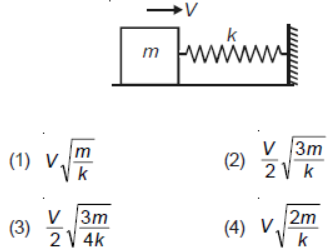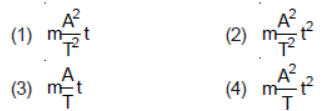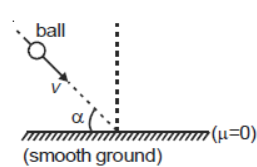Please refer to MCQ Questions Chapter 6 Work Energy and Power Class 11 Physics with answers provided below. These multiple-choice questions have been developed based on the latest NCERT book for class 11 Physics issued for the current academic year. We have provided MCQ Questions for Class 11 Physics for all chapters on our website. Students should learn the objective based questions for Chapter 6 Work Energy and Power in Class 11 Physics provided below to get more marks in exams.
Chapter 6 Work Energy and Power MCQ Questions
Please refer to the following Chapter 6 Work Energy and Power MCQ Questions Class 11 Physics with solutions for all important topics in the chapter.
MCQ Questions Answers for Chapter 6 Work Energy and Power Class 11 Physics
Question. The magnitude of work done by a force :
(a) depends on frame of reference
(b) does not depend on frame of reference
(c) cannot be calculated in non-inertial frames.
(d) both (a) and (b)
Answer
A
Question. A vehicle is moving with a uniform velocity on a smooth horizontal road, then power delivered by its engine must be
(a) uniform
(b) increasing
(c) decreasing
(d) zero
Answer
D
Question. Work done by a conservative force is positive if
(a) P.E. of the body increases
(b) P.E. of the body decreases
(c) K.E. of the body increases
(d) K.E. of the body decreases
Answer
B
Question. Which of the following force(s) is/are non-conservative?
(a) Frictional force
(b) Spring force
(c) Elastic force
(d) All of these
Answer
A
Question. An automobile engine of mass M accelerates and a constant power p is applied by the engine. The instantaneous speed of the engine will be
(a) [Pt /M]1/ 2
(b) [2Pt /M]1/ 2
(c) [Pt / 2M]1/ 2
(d) [Pt / 4M]1/ 2
Answer
B
Question. A ball of mass m and a ball B of mass 2m are projected with equal kinetic energies. Then at the highest point of their respective trajectories.
(a) P.E. of A will be more than that of B
(b) P.E of B will be more than that of B
(c) P.E of A will be equal to that of B
(d) can’t be predicted.
Answer
C
Question. The vessels A and B of equal volume and weight are immersed in water to depth h. The vessel A has an opening at the bottom through which water can enter. If the work done in immersing A and B are WA and WB respectively, then
(a) WA = WB
(b) WA < WB
(c) WA > WB
(d) WA >< WB
Answer
B
Question. A bullet fired into a fixed target loses half of its velocity after penetrating 3 cm. How much further it will penetrate before coming to rest assuming that it faces constant resistance to motion ?
(a) 2.0 cm
(b) 3.0 cm
(c) 1.0 cm
(d) 1.5 cm
Answer
C
Question. A block is acted upon by a force, which is inversely proportional to the distance covered (x). The work done will be proportional to
(a) x
(b) x1/2
(c) x2
(d) None of these
Answer
D
Question. Consider the following two statement:
I. Linear momentum of a system of particles is zero.
II. Kinetic energy of a system of particles is zero.
Then
(a) I implies II but II does not imply I.
(b) I does not imply II but II implies I.
(c) I implies II and II implies I.
(d) I does not imply II and II does not imply I.
Answer
B
Question. A moving body with a mass m1 and velocity u strikes a stationary body of mass m2. The masses m1 and m2 should be in the ratio m1/m2 so as to decrease the velocity of the first body to 2u/3 and giving a velocity of u to m2 assuming a perfectly elastic impact. Then the ratio m1/m2 is
(a) 5
(b) 1/ 5
(c) 1/ 25
(d) 25.
Answer
A
Question. A motor cycle is moving along a straight horizontal road with a speed v0. If the coefficient of friction between the tyres and the road is m, the shortest distance in which the car can be stopped is

Answer
A
Question. Which of the following must be known in order to determine the power output of an automobile?
(a) Final velocity and height
(b) Mass and amount of work performed
(c) Force exerted and distance of motion
(d) Work performed and elapsed time of work
Answer
D
Question. The engine of a truck moving along a straight road delivers constant power. The distance travelled by the truck in time t is proportional to
(a) t
(b) t2
(c) √t
(d) t3/2
Answer
D
Question. The work done in stretching a spring of force constant k from length l1 and l2 is

Answer
B
Question. In case of elastic collision, at the time of impact.
(a) total K.E. of colliding bodies is conserved.
(b) total K.E. of colliding bodies increases
(c) total K.E. of colliding bodies decreases
(d) total momentum of colliding bodies decreases.
Answer
C
Question. If the force acting on a body is inversely proportional to its velocity, then the kinetic energy acquired by the body in time t is proportional to
(a) t0
(b) t1
(c) t2
(d) t4
Answer
B
Question. The engine of a vehicle delivers constant power. If the vehicle is moving up the inclined plane then, its velocity,
(a) must remain constant
(b) must increase
(c) must decrease
(d) may increase, decrease or remain same.
Answer
A
Question. A bullet of mass ‘a’ and velocity ‘b’ is fired into a large block of wood of mass ‘c’. The bullet gets embedded into the block of wood. The final velocity of the system is

Answer
C
Question. Johnny and his sister Jane race up a hill. Johnny weighs twice as much as jane and takes twice as long as jane to reach the top . Compared to Jane
(a) Johnny did more work and delivered more power.
(b) Johnny did more work and delivered the same amount of power.
(c) Johnny did more work and delivered less power
(d) Johnny did less work and johnny delivered less power.
Answer
B
Question. A body of mass m moving with velocity v makes a head on elastic collision with another body of mass 2m which in initially at rest. The loss of kinetic energy of the colliding body (mass m ) is
(a) 1/2 of its initial kinetic energy
(b) 1/9 of its initial kinetic energy
(c) 8/9 of its initial kinetic energy
(d) 4/1of its initial kinetic energy
Answer
C
Question. Which one of the following physical quantities is represented by the shaded area in the given graph?

(a) Torque
(b) Impulse
(c) Power
(d) Work done
Answer
D
Question. A particle of mass m1 moving with velocity v collides with a mass m2 at rest, then they get embedded. Just after collision, velocity of the system
(a) increases
(b) decreases
(c) remains constant
(d) becomes zero
Answer
B
Question. A particle describe a horizontal circle of radius 0.5 m with uniform speed. The centripetal force acting is 10 N. The work done in describing a semicircle is
(a) zero
(b) 5 J
(c) 5 π J
(d) 10 π J
Answer
A
Question. A mass m1 moves with a great velocity. It strikes another mass m2 at rest in a head on collision. It comes back along its path with low speed, after collision. Then
(a) m1 > m2
(b) m1 < m2
(c) m1 = m2
(d) cannot say
Answer
B
Question. A cord is used to lower vertically a block of mass M, a distance d at a constant downward acceleration of g/4. The work done by the cord on the block is

Answer
C
Question. If the linear momentum is increased by 5%, the kinetic energy will increase by
(a) 50%
(b) 100%
(c) 125%
(d) 10%
Answer
D
Question. Calculate the K.E and P.E. of the ball half way up, when a ball of mass 0.1 kg is thrown vertically upwards with an initial speed of 20 ms–1.
(a) 10 J, 20 J
(b) 10 J, 10 J
(c) 15 J, 8 J
(d) 8 J, 16 J
Answer
B
Question. A ball projected from ground at a certain angle collides a smooth inclined plane at the highest point of its trajectory. If the collision is perfectly inelastic then after the collision, ball will
(a) come to rest
(b) move along the incline
(c) retrace its path.
Answer
B
Question. A spring of force constant 800 N/m has an extension of 5 cm. The work done in extending it from 5 cm to 15 cm is
(a) 16 J
(b) 8 J
(c) 32 J
(d) 24 J.
Answer
B
Question. A force F→ = (5i→ + 3 j→ + 2k→) N is applied over a particle which displaces it from its origin to the point r→ = (2i→ – j→)m. The work done on the particle in joule is
(a) +10
(b) +7
(c) –7
(d) +13
Answer
B
Question. When the kinetic energy of a body is increased to three times, then the momentum increases
(a) 6 times
(b) 1.732 times
(c) √2 times
(d) 2 times
Answer
B
Question. Two bodies of masses 2 m and m have their KE in the ratio 8 : 1. What is the ratio of their momenta ?
(a) 8 : 1
(b) 4 : 1
(c) 2 : 1
(d) 1 : 1
Answer
B
Question. A spring of spring constant 5 × 103 N/m is stretched initially by 5 cm from the unstretched position. Then the work required to stretch it further by another 5 cm is
(a) 18.75 J
(b) 25.00 J
(c) 6.25 J
(d) 12.50 J
Answer
A
Question. A cord is used to lower vertically a block of mass M, through a distance d at a constant downward acceleration of g/8. Then the work done by the cord on the block is
(a) Mg d/8
(b) 3 Mg d/8
(c) Mg d
(d) – 7 mg d/8
Answer
D
Question. Two solid rubber balls A and B having masses 200 & 400 gm respectively are moving in opposite direction with velocity of A equal to 0.3 m/sec. After collision the two balls come to rest when the velocity of B is
(a) 0.15 m/sec
(b) 1.5 m/sec
(c) –0.15 m/sec
(d) None of these
Answer
A
Question. The rest energy of an electron is 0.511 MeV. The electron is accelerated from rest to a velocity 0.5 c. The change in its energy will be
(a) 0.026 MeV
(b) 0.051 MeV
(c) 0.08 MeV
(d) 0.105 MeV
Answer
C
Question. A bomb of mass 9 kg explodes into the pieces of masses 3 kg and 6 kg. The velocity of mass 3 kg is 16 m/s. The kinetic energy of mass 6 kg in joule is
(a) 96
(b) 384
(c) 192
(d) 768
Answer
C
Question. A long string is stretched by 2 cm and the potential energy is V. If the spring is stretched by 10 cm, its potential energy will be
(a) V / 25
(b) V/5
(c) 5 V
(d) 25 V
Answer
D
Question. A body of mass 5 kg initially at rest explodes into 3 fragments with mass ratio 3 : 1 : 1. Two of fragments each of mass ‘m’ are found to move with a speed 60 m/s in mutually perpendicular directions. The velocity of third fragment is
(a) 60 √2
(b) 20 √3
(c) 10 √2
(d) 20 √2
Answer
D
Question. A sphere of mass 8m collides elastically (in one dimension) with a block of mass 2m. If the initial energy of sphere is E. What is the final energy of sphere?
(a) 0.8 E
(b) 0.36 E
(c) 0.08 E
(d) 0.64 E
Answer
B
Question. A bomb of mass 16kg at rest explodes into two pieces of masses 4 kg and 12 kg. The velolcity of the 12 kg mass is 4ms–1. The kinetic energy of the other mass is
(a) 144 J
(b) 288 J
(c) 192 J
(d) 96 J
Answer
B
Question. A machine, which is 75% efficient, uses 12 J of energy in lifting up a 1 kg mass through a certain distance. The mass is then allowed to fall through that distance. The velocity
at the end of its fall is (in m/s)
(a) √24
(b) √12
(c) √18
(d) √9
Answer
C
Question. A body accelerates uniformly from rest to a velocity of 1 ms–1 in 15 seconds. The kinetic energy of the body will be (2/9) J when ‘t’ is equal to [Take mass of body as 1 kg]
(a) 4s
(b) 8s
(c) 10s
(d) 12s
Answer
C
Question. A small body is projected in a direction inclined at 45º to the horizontal with kinetic energy K. At the top of its flight, its kinetic energy will be
(a) Zero
(b) K/2
(c) K/4
(d) K/√2
Answer
B
Question. A body is dropped from a height of 20m and rebounds to a height 10m. The loss of energy is
(a) 10%
(b) 45%
(c) 50%
(d) 75%
Answer
C
Question. A machine gun fires a bullet of mass 40 g with a velocity 1200 ms–1. The man holding it can exert a maximum force of 144 N on the gun. How many bullets can he fire per second at the most?
(a) 2
(b) 4
(c) 1
(d) 3
Answer
D
Question. A crane is used to lift 1000 kg of coal from a mine 100 m deep. The time taken by the crane is 1 hour. The efficiency of the crane is 80%. If g = 10 ms–2, then the power of the

Answer
D
Question. A body of mass m is suspended from a massless spring of natural length l. It stretches the spring through a vertical distance y. The potential energy of the stretched spring is

Answer
A
Question. Ten litre of water per second is lifted from a well through 10 m and delivered with a velocity of 10 ms–1. If g = 10 ms–2 , then the power of the motor is
(a) 1 kW
(b) 1.5 kW
(c) 2 kW
(d) 2.5 kW
Answer
B
Question. A block moving with speed V starts compressing a spring of spring constant k as shown in figure. The compression in spring when speed of block becomes V/2 is

Answer
B
Question. Work done against spring force in increasing the extension in a spring from x1 to x2 is (spring constant is k)

Answer
C
Question. A body of mass m initially at rest starts moving and attains a velocity A in time T. Then, what is the instantaneous power delivered by force to the body in time t?

Answer
A
Question. If coefficient of restitution between ball and ground is e, then find speed of ball just after collision

(a) ev
(b) v
(c) v √sin2α + θ2cos2α
(d) v √cos2α + θ2sin2α
Answer
D
Question. A radioactive nucleus of mass number A initially at rest emits an α-particle having kinetic energy K. The KE of recoiling nucleus will be
(a) K
(b) K/A−4
(c) 4K/A−4
(d) K/4
Answer
C
Question. If a small particle of mass m is released from horizontal position as shown. (c is centre of circular path). Then the maximum tension in thread will be

(a) mg
(b) 2mg
(c) 3mg
(d) 4mg
Answer
C
Question. A ball is dropped from height 32 cm above ground level. If the coefficient of restitution between the ball and ground is 0.5 then, to what height will it rise after first collision?
(a) 16 m
(b) 8 m
(c) 4 m
(d) 0.8 m
Answer
D
Question. A bullet of mass m moving horizontally with velocity v is fired into a large wooden block of mass M kept at rest on a smooth horizontal surface. The magnitude of final velocity of this bullet-block system is
(a) (m + M)v /m
(b) (m + M)v /M
(c) mv/M+m
(d) (M – m)v /m
Answer
C
Question. A ball of mass 10 kg is moving with velocity 10 m/s strikes the bob of a pendulum at rest. The mass of the bob is also 10 kg. If the collision is perfectly inelastic, then the height to which the combination of two will rise is
(a) 2 m
(b) 1.6 m
(c) 1 m
(d) 1.25 m
Answer
D
Question. A ball is dropped from a height h = 10 m on the ground. If the coefficient of restitution is e, the height to which the ball goes up after it rebounds for the nth time is
(a) e2n/10 m
(b) 10e2n m
(c) ne10 m
(d) 10en m
Answer
B
Question. A bullet of mass m is moving with speed u hits a stationary wooden block of mass M placed on a smooth surface and gets embedded into it, then the percentage loss of energy during collision is

Answer
A
Question. The blocks shown in figure are identical and each has mass 2 kg. If block A moving with speed 4 m/s collides with B and collision is perfectly elastic then the maximum compression produced in spring will be [spring constant k = 100 N/m]

(a) 0.4 m
(b) 0.8 m
(c) 1.2 m
(d) 1.6 m
Answer
A
Question. A bullet loses 1/n th of its velocity passing through one plank. How many such planks are required to stop the bullet?
(a) (2n–1/n2)
(b) (n/n–1)
(c) n2(2n –1)
(d) (n–1)/n
Answer
C

We hope you liked the above provided MCQ Questions Chapter 6 Work Energy and Power Class 11 Physics with solutions. If you have any questions please ask us in the comments box below.

